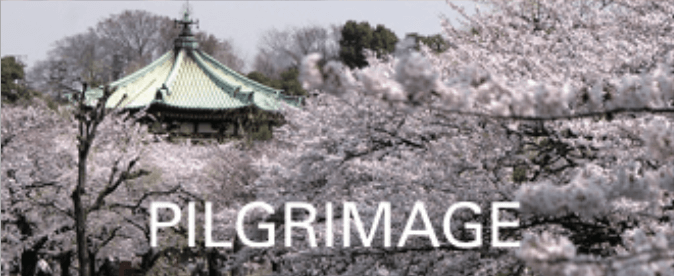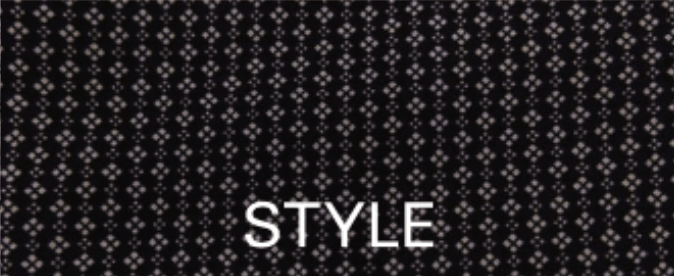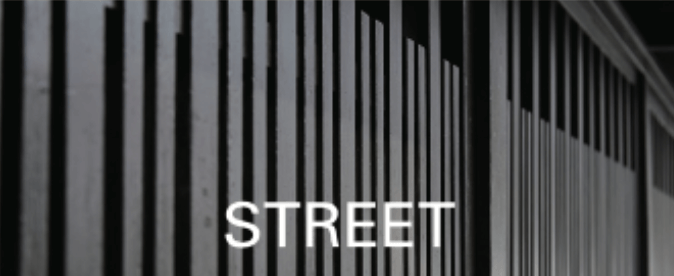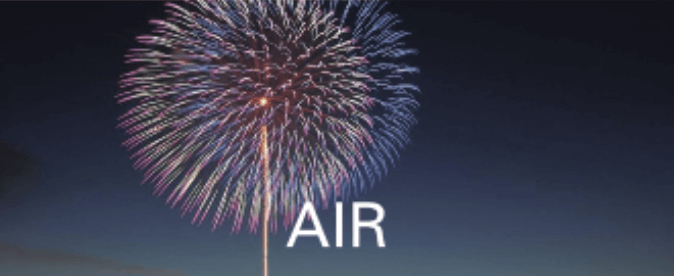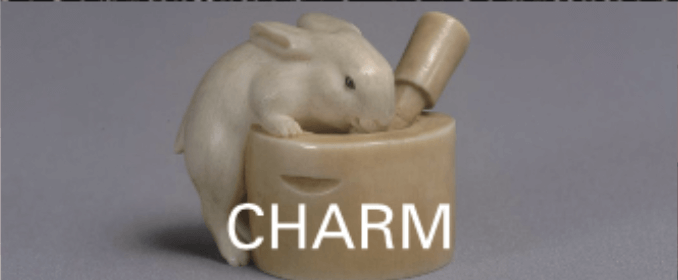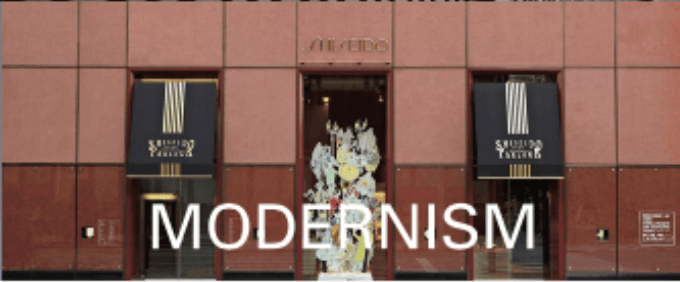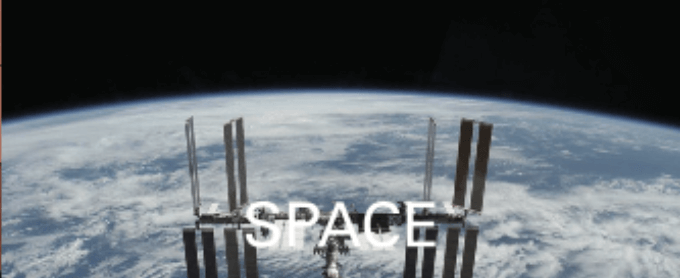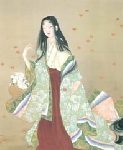
This museum exhibits works by Uemura Shoen (1875 – 1949), Uemura Shoko (1902 – 2001), the son of Shoen, and Uemura Atsushi (1933 – ), the grandson of Shoen.
There is Hanagatami, Flower basket by Uemura Shoen – Drawing Teruhinomae, a lover of Prince Oatobe (later Emperor Keitai in the 6th century) at Hanagatami, of Noh Kyogen, a farce by Zeami Motokiyo (1363 – 1443), an aesthetician, actor and Noh playwright. Shoen drew the elegant and refined insanity.
The expressions of an insane person’s face do not change like a Noh Mask. It is difficult to capture the emptiness. – A mysterious light appears in the eyes of the insane person and the line of sight turns. The person faces the emptiness as the opponent. The blossom and life are passing, and the passing is emptiness itself.
The beauty of the passage of the nature is a theme of Japanese beauty.
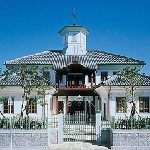
This museum is a former Hachiman Higashi Gakko (school), which was built in 1877 in Omi Hachiman City, to boast the appearance of the riverside district and merchant houses. It was restored to its original structure in 1994. The restored interior and architecture shows the dawn of modern times.
This school was opened by the donations of Omi shonin, merchants of Omi Province, who aimed to improve children’s education, after the Meiji Restoration, the event that brought back practical imperial rule of the Empire of Japan in 1868 under Emperor Meiji.
This restored building conveys the history of Omi shonin, who had refined the insight to judge the days from the Age of Provincial Wars in the 15th – 16th centuries.
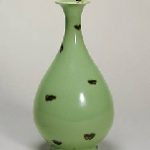
This museum possesses approximately 6,000 items, including two National Treasures, which are mainly Korean and Chinese porcelains.
The National Treasure Tobiseijihanaike – the Flower vase of Longquan celadon, with a flying iron mottle, is a masterpiece from the Yuan Dynasty (1279 – 1368), which has a flying iron mottle on the surface of the vase and was fired with celadon glaze. Its style is Gyottukoshun, the celadon vase characterized by having a thin neck, body with a bulge, and a trumpet-shaped opening.
It has a good contrast between the neck and the body and was popular in the Yuan Dynasty (1279 – 1368). Its appearance is beautiful. The glazed color is a slightly yellow celadon.
This masterpiece came from the Osaka Konoike family, Japan’s largest conglomerate in the Edo period (1603 – 1868).

The Akashi Kaikyo Bridge is the longest suspension bridge in the world. Both ancient elephants and ancients knew the time by the sun’s rays. One aspect of the modernization of civilizations was the setting of standard time in human society. The 1,084 sets of illumination lamps are installed at this bridge, too.
This bridge is close to the Japan Standard Time Meridian, which shines blue on weekdays in the summer and becomes rainbow color every hour on the hour. This bridge is a modern sundial.
– The relics of ancient elephants and ancients were founded in Akashi City, too.
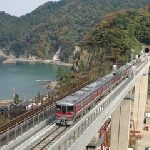
The Amarube Viaduct replaced the Amarube iron trestle-type bridge, which was the longest such bridge in Japan. The height is about 41m. The view of this viaduct as “the air train” is as beautiful as the Amarube iron bridge, which became a new symbol of Amarube.
The remaining three piers of the Amarube iron bridge have been maintained and are open to the public as an observation facility “Sora no Eki – the station in the sky”. You can reach the station by the elevator named Amarube Crystal Tower.
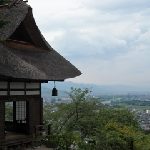
Chikuma city is a famous spot for the moon. The famous moon from Mt. Kyodaisan on the other side of the river, and “Tagoto no Tuki: the moon reflected in several rice-fields lying in tiers on a hillside”, comforted the hearts of the people, since ancient times.
The magnificent view also became a poem by Matsuo Basho (1644 – 1694), the most famous poet of the Edo period. The night view along the Chikuma River extends to Zenkoji daira, basin, under the stars in the sky. This temple faces the rice terrace of “Tagoto no Tuki” and an ancient temple of the Tendai sect.
This temple was a sacred place of Haikai, the world of Haiku, seventeen-syllable verse, loved very much by writers and artists. There are many monuments of Haiku and poems lined up in the precincts.
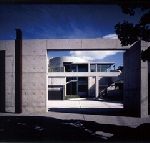
This memorial museum is built at the birthplace of Nakahara Chuuya (1907 – 1937), a Japanese poet, at Yuda Onsen, hot spring, Yamaguchi City. It exhibits valuable materials such as handwritten manuscripts, diaries, and letters by the modern poet, Nakahara Chuuya, who died at the age of 30.
You can enjoy the world of Chuya’s poetry, no matter how many times you visit, as it changes its display several times a year. Chuya left two poetry books in his lifetime and he introduced French poets, by publishing the poetry of Arthur Rimbaud (1854 – 1891), a French poet and arms dealer. He is also known as Japan’s Rimbaud.
– Rimbaud said, “Visionary power will be attained with a long-term, vast, marginal and rational confusion of all senses.” Chuya’s poems have captured the hearts of many people and are still widely loved in Japan. – The elegance of poetic unconventionality has been loved in Japan since ancient times.

Fumeikaku, next to the main building of Saihoji Hondo, was built in 1758, which was built in the Hosangen style, using a total of 12 columns and has the double pyramidal roof tiled in the Hongawarabuki style, a roof with formal tiles. Fumeikaku, is seen as a triangle from every direction. Its stage imitates the stage of Kiyomizudera Temple in Kyoto.
The unique roof could have been seen from anywhere in the town, and Fumeikaku could have overlooked the town of Takehara. The tea room of the houses in Takehara, have windows with views of Fumeikaku and the moon.
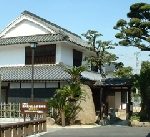
In 1878, Isozaki Minki (1834 – 1908): a Japanese textile weaver and inventor, completed the “Kinkanen (figured mat)”, known to the world with its name, by the weaving machine and method to make accurate and elaborate mats from rushes of Okayama specialty.
This museum used to be a residence and work place for Minki. A slope was placed in the building for loading and unloading of goods and pulleys were set up in the atrium of the earth floor. The entrance is opened and closed by turning and sliding, and the windows on the second floor have shutters protruding outside.
Devices and Efficiency by individual effort, are the style of the Meiji period (1868 – 1912).
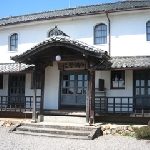
Sashi Shuzan (1829 – 1896), opened a private school of Chinese classics in Unomachi Town, Seiyo City for 11 years from 1858. He sparked the enthusiasm of education for the townspeople and was the model for the Chinese classics teacher in the novel “Botchan”, by Soseki Natsume (1867 – 1916): a Japanese novelist. Natsume is best known around the world for his novel Botchan, whose theme is morality.
The story is based on the author’s personal experience as a teacher dispatched to Matsuyama Ehime. Shingi-do was the predecessor of Kaimei Gakko, which was built by his disciples and students of Shuzan. More than 90 hanging wall charts used for textbooks in the Meiji period (1868 – 1912), are stored at this school and are considered across Japan as valuable materials.
It shows that the education system of Terakoya: a private elementary school in the Edo period (1603 – 1868), achieved greatness.

This museum is located on Omishima Island, which is the central part of the Shimanami Kaido, a 60 km long toll road that connects Japan’s main island of Honshu to the island of Shikoku, passing over six small islands in the Seto Inland Sea. You can see the flow of modern Japanese painting from the latter half of the the Showa period (1926 – 1989).
The Memorial Exhibition Room of Tabuchi Toshio (1941 -) was made to commemorate the 10th anniversary of the museum’s opening. The Exhibition Room exhibits his works and also drawings where his emotion in the production process were recorded. Tabuchi said, “The real thing is only what is in front of you. No one can draw the real thing from a picture”. – Tabuchi said that this is time’s real witness.
